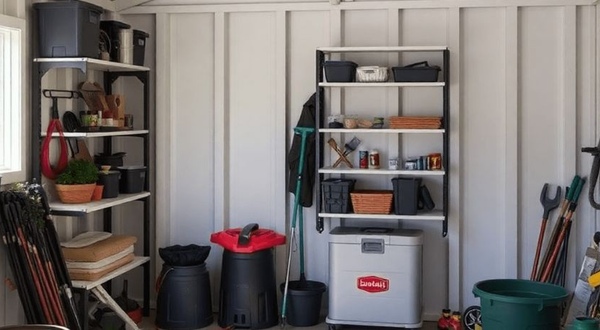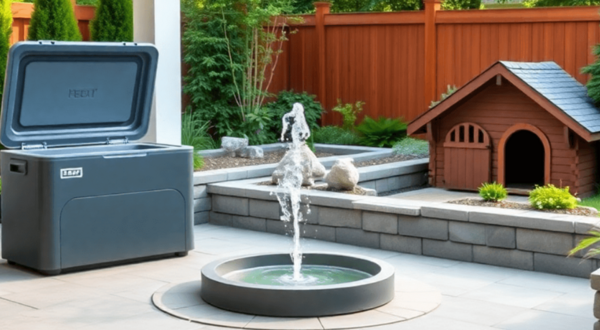
Begin by measuring the dimensions of your patio. Note any unique features, such as irregular shapes or built-in structures. Identify areas that receive direct sunlight versus shaded spots. A thorough understanding of the space helps in selecting proportionate furniture that fits comfortably. Ensure pathways are clear for easy movement. Consider the placement of utilities like grills, electrical outlets, or garden hoses. This strategic assessment allows for an organized and functional layout that maximizes your outdoor area's potential.
Firstly, measure the entire patio area to understand its dimensions. Identify any irregular shapes or obstacles like built-in structures and landscaping elements. Consider the flow of foot traffic and ensure ample space for movement. Mark out sunny and shaded spots. These details help in planning an efficient layout. Finally, visualize potential zones for different activities, such as dining or lounging. This strategic assessment ensures a functional and aesthetically pleasing outdoor environment.
Selecting the appropriate material for patio furniture is crucial. Different materials offer varying levels of durability, comfort, and maintenance requirements. Aluminum is lightweight and rust-resistant, making it ideal for humid climates. Wicker provides a natural look but may require more upkeep. Teak wood is highly durable and ages beautifully, albeit at a higher cost. Steel offers sturdiness but might rust without proper care. Understanding the pros and cons of each material helps in making an informed decision that aligns with the specific needs and environment.
Prior to purchasing patio furniture, it is vital to assess the intended use. Will the space be primarily for dining, lounging, or social gatherings? Identifying the primary function will help narrow down choices. Additionally, consider personal style preferences. Modern, rustic, or traditional designs offer varied aesthetics. Matching the furniture to the overall home design creates a cohesive look. It’s important to balance functionality with visual appeal to achieve the desired ambiance.
Understanding how the patio space will be used is crucial. Some may prioritize outdoor dining, requiring a large table and ample seating. Others might prefer a lounge setup with comfortable chairs and sofas for relaxation. Social gatherings may necessitate a blend of both dining and lounging options. By pinpointing the main activities, it becomes easier to choose pieces that align with those specific needs. Proper planning ensures the space is functional and enjoyable for its intended purpose.
Choosing patio furniture that aligns with the homeowner's personal style enhances outdoor enjoyment. Modern, sleek designs appeal to those who prefer a contemporary look. Traditionalists may lean towards classic, ornate pieces. Natural materials like wood or wicker create a cozy, rustic ambiance. Minimalist designs with clean lines work well for those seeking simplicity. Color schemes should complement the existing outdoor decor. By matching furniture to the overall aesthetic, the patio becomes an extension of the home’s interior style.
Choosing the right material for patio furniture is crucial. Wood offers a natural, timeless look but requires maintenance. Metal, particularly aluminum, is durable and low-maintenance. Wicker provides a cozy, traditional ambiance, suitable for covered areas. Plastic and resin are affordable and weather-resistant options. Each material presents unique benefits and drawbacks. It’s essential to consider climate and usage. Proper material selection ensures longevity and satisfaction with the furniture. Balancing aesthetics and practicality leads to a well-appointed patio.
Patio furniture comes in various materials, each offering distinct advantages. Wood exudes a natural charm and ages beautifully but demands regular upkeep. Aluminum is prized for being lightweight, rust-resistant, and low-maintenance, making it ideal for varied climates. Wicker, often crafted from natural or synthetic fibers, lends a classic and cozy feel, best under covered spaces. Plastic and resin are affordable choices, offering durability and easy cleaning, making them suitable for all weather conditions. Consider these options carefully for a well-informed decision.
Wood offers a timeless aesthetic but requires regular maintenance against weather damage. Aluminum is lightweight and rust-resistant, yet it may lack the warmth of natural materials. Wicker provides a cozy and classic look but can deteriorate if exposed to extreme conditions. Plastic and resin are affordable and easy to clean; however, they might not offer the same level of sophistication. Each material presents unique considerations to balance between appearance, durability, and upkeep.
When selecting patio furniture, prioritizing comfort is essential. Opt for ergonomic designs that support proper posture. Cushions can enhance comfort, and waterproof options are recommendable. Functionality is equally important; consider features like foldable chairs for easy storage. Tables with adjustable heights offer versatility for different activities. Umbrella holders and built-in storage can add convenience. Ensure that furniture pieces fit seamlessly into the available space, providing both comfort and utility. This balance will maximize the enjoyment of your outdoor area.
When selecting patio furniture, comfort should be a top priority. Ergonomic designs that offer proper support can greatly enhance outdoor relaxation. Look for chairs with curved backs and armrests to reduce strain. Cushions made from high-density foam provide added comfort and longevity. Adjustable features, such as reclining mechanisms, can cater to various sitting preferences. It’s also important to test the furniture in person when possible to ensure it meets ergonomic standards. Prioritizing these elements ensures a relaxing and enjoyable patio experience.
Incorporating functional features in patio furniture enhances usability and convenience. Foldable and stackable designs allow for easy storage and space management. Look for pieces with adjustable settings to accommodate different activities, such as dining or lounging. Built-in storage options, like under-seat compartments, add practicality. Weather-resistant materials ensure longevity and low maintenance. Removable and washable cushion covers simplify cleaning and care. These features contribute to a versatile and user-friendly outdoor setting.
Outdoor furniture must withstand various weather conditions. Choosing pieces crafted from weather-resistant materials is essential. Synthetic wicker, teak, and powder-coated aluminum are popular choices for their durability. UV protection helps prevent color fading, while rust-resistant coatings preserve metal frames. Regular maintenance, such as cleaning and protective covers, extends the lifespan of patio furniture. Investing in high-quality materials ensures long-lasting enjoyment and reduces the need for frequent replacements. Prioritizing durability and weather resistance enhances the value of outdoor furniture.
Selecting furniture that withstands the elements is crucial for outdoor settings. Weather-resistant materials like synthetic wicker, teak, and powder-coated aluminum are top choices. These materials fend off moisture, sun damage, and temperature fluctuations. Durable furniture ensures longevity, reducing replacement costs over time. Quality construction resists wear and tear, maintaining aesthetic appeal. Investing in robust materials provides peace of mind, knowing the pieces will remain functional and attractive throughout seasons. Prioritizing durability enhances outdoor enjoyment and overall investment value.
Regular cleaning is essential to maintain patio furniture longevity. Use mild soap and water to remove dirt and grime. For metal furniture, consider applying a protective coat to prevent rust. Cover furniture when not in use, especially during harsh weather conditions. Store cushions and fabrics indoors to avoid mildew and discoloration. Periodically tighten screws and bolts to keep structural integrity. Lastly, follow manufacturer guidelines for specific maintenance tasks, ensuring each material type receives appropriate care.
Setting a budget is crucial for any patio furniture purchase. Determine how much you're willing to spend before exploring options. Look for seasonal sales and discounts to maximize savings. Quality doesn't always mean expensive; there are affordable options that offer durability and style. Consider shopping at reputable retailers, both online and in-store. Check reviews and compare prices to ensure you're getting the best deal. Prioritizing value over cost can result in a more satisfying investment.
Determining an appropriate budget is essential for any patio furniture acquisition. Start by assessing how much can be comfortably spent without compromising other financial goals. It's advisable to research different price ranges to understand what quality options are available within the budget. Consider potential costs for additional items like cushions, covers, or maintenance products. Remember that investing in durable, weather-resistant pieces may save money in the long run by reducing the need for frequent replacements. Budgeting wisely ensures a satisfactory purchase.
Several retailers offer a blend of quality and affordability for patio furniture. Online marketplaces like Amazon and Wayfair provide extensive selections and customer reviews, aiding in informed decisions. Big-box stores such as Home Depot and Lowe’s frequently feature seasonal sales. Local furniture stores and specialty shops might have unique pieces at competitive prices. For those seeking budget-friendly options, consider estate sales or second-hand furniture stores. Each option ensures accessibility to patio furniture that fits both quality standards and budget constraints.


